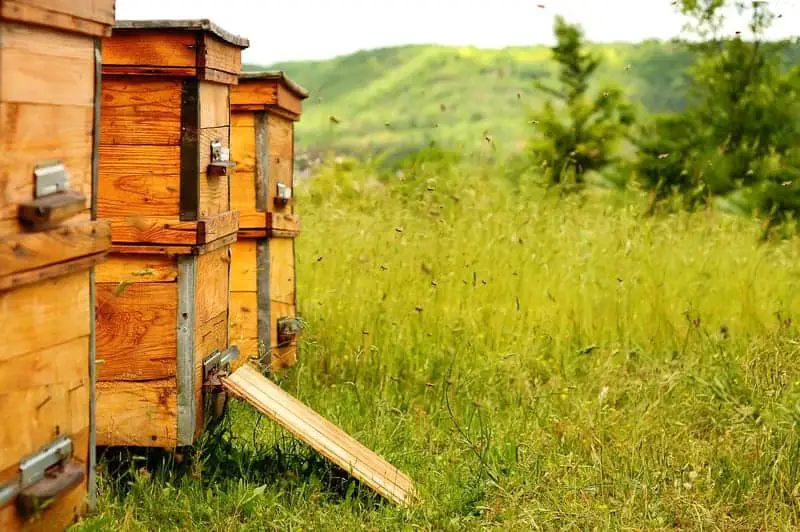There are numerous benefits to keeping bees at home no matter where you live.
But, what do you do about beehive placement? After all, where you set up your bee hive is essential to its success.
There are three main factors you have to consider when trying to decide where you should be setting up bee hives should.
- Your Bees
- Your neighbors
- Your family.
We’re going to go over each of these to help you choose the perfect location for your bees.
Keep reading to find out more about beehive placement!
Table of Contents
Step 1: Consider The Bees
Bees are relatively simple creatures with just three basic needs. If you meet these, you’ll have happy bees that are healthy and produce a lot of honey for you!
A good beehive set up is important, so here are the three things your bees need:
Food
You should have plenty of flowering plants that these little pollinators love. They’ll also need to look around the neighborhood for food unless you have a massive flower garden, but you want to ensure they have something nearby.
Some of the best flowers for bees are:
- Sunflowers
- Lilac
- Mint
- Lavender
- Black-eyed Susans
- Poppies
If you haven’t already planted some of these, be sure to find some places around your yard to fit them in. Many of these also do well in pots which can make it easy to move them closer to your hives if needed.
Water
Like all living creatures, bees need a source of water. It’s important to ensure that the source won’t run dry and that it’s safe for them. For example, a deep bucket with slick sides will trap and drown bees inside.
A birdbath is an example of a great option for a bee waterer. You’ll want to fill it with natural stones that will give the bees an easy way to get to the water without falling in.
You may also consider using something like a chicken waterer. These hold large amounts of water which means a lower chance of it running out, plus is less work for you. Again, you’ll want to add stones to it to avoid drowning.
Your water source should be as close to the hive as possible. This is because there is a group of worker bees that do all the water collecting for the hive.
Water isn’t stored in the hive, so this group of bees is constantly going out and bringing back water to share with others. So, when you keep the water source nearby, you ensure the whole hive stays cool and hydrated.
Space
The final thing that bees need is space around their hive. They feel safest if potential threats to the hive stay at least 10 feet away, so your beehive should be in a fairly secluded area. This will reduce stress in your hive.
Bees also need room to enter and leave the hive. If they have a hard time getting in and out, they might consider moving to a better location or could become stressed. Either way, you want to make sure your bees have the space they need.
Something that’s often overlooked is, will you be positioning your beehive on ground or on a stand?
Step 2: Consider Your Neighbors
Some people will be completely on board with you having bees. They’ll be thrilled to have the extra pollinators for their garden and will even plant extra flowers just to attract your bees to their yard.
But most neighbors will be a little more apprehensive about your new project and a few may even outright object to it. No matter what your neighbors think of your adventure into beekeeping, you need to take a few steps to keep the peace.
Here are a few tips to satisfying your neighbors:
Take Care of Your Bees
If your bees are taken care of as mentioned above, it will keep them away from your neighbor’s property for the most part. For example, if you’re giving plenty of water to your bees, they won’t have to visit your neighbor’s pool for a drink.
Educate Them
It’s also important to educate your neighbors about the importance of bees, and how they’re different from wasps and other stinging insects. Some people lump together these animals without realizing how helpful bees are!
Take time to explain to your neighbor why you’re getting bees and how they’ll benefit the whole neighborhood. This alone may be enough to give people the peace of mind they need to accept your new addition.
While you’re at it, you also need to educate them on the danger of pesticides. Encourage them to avoid using them as much as possible. Most importantly, they shouldn’t use them on plants while they’re flowering.
Offer Them Honey
Possibly one of the easiest ways to appease your neighbors is to offer them honey from your hive. Few people would turn down a small jar of delicious local honey, and it might even get them to start planting bee-friendly flowers!
Step 3: Consider Your Family
The final thing you have to consider is yourself and your family. If you have a small backyard and kids that love to play in it, you’ll have to be strategic to avoid any unwanted interactions between your bees and children.
Pets should also be given plenty of space of their own so they don’t disturb the hive. If you have overly-curious animals, you may need to keep the hive area fenced off to prevent an unexpected trip to the vet.
You’ll also want to have the hive close enough to keep an eye on it. The sooner you recognize a problem, the sooner you can solve it. However, if the beehive is too far from your home, it’s easy to forget to regularly check in on your bees.
🍯What is the Ideal Beehive Placement Location?
The ideal location for your beehive should be at least 10 feet from all structures and areas where people or animals frequent. You also want to keep food and water sources as close to the hive as possible.
🐝What Direction Should a Beehive Face?
A beehive entrance should ideally be faced towards the east, or southeast. This is to provide morning sunlight into the hive, so that the bees know it’s their time to go out and work.
🍯What Should I Put Under My Bee Hives?
A lot of beekeepers will position their beehive on the ground, using a layer of wood chips or mulch for the foundation.
However, we personally think that a hive stand like the one shown in the image below is a great idea. Helping to prevent small rodents from pestering your colony.
Either way, this is probably an afterthought, once you’ve found an ideal hive location.

Learn More About Backyard Beekeeping
Now you know everything you need to know about beehive placement. Hopefully, with this information, you’ll be ready to set up your hive in its ideal location.
If you want to learn more about getting started as an urban beekeeper, be sure to check out our city dweller’s guide that’s packed with useful information to get you started with beekeeping.

